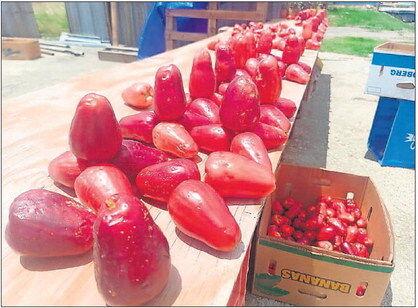(Trinidad Express) Roadside vendors are defending the cost of their goods against criticism from consumers that the prices of pomerac and mango are too high when compared to imported apples.
They say consumers are unaware of the various expenses involved in bringing goods from the tree to the consumer.
These unseen costs include labour and transportation.
The Express yesterday spoke to two roadside vendors who both sold mangoes and pomeracs. At both locations, four mangoes were sold for $25 and four pomeracs for $20.
Debe fruit vendor Karlon Roberts, 47, told the Express that before a mango is picked, the price begins to accumulate.
‘It starts from the person who owns the tree. We does normally pay between $1 and $3 for a mango. When we go to buy, we offer a dollar. Most people want two, some want $3, but we try to pay $1. Majority of time, we get in-between, so we pay $2,’ he said.
Every job, said Roberts, included $300 to pay a climber and at least $200 for gas to transport the goods, which usually came from areas such as Cedros, La Brea, Mayaro, Manzanilla or Arima.
He said these separate costs of gas, labour, and price of the fruit dictated the cost to the consumer.
Another factor that affected cost was the availability of the fruit, he continued.
Roberts gave the example of mangoes, which he said was now ‘coming in season’. At the beginning of the year, a heap of four mangoes was being sold for $40. However, he anticipated that the price would soon drop to between $15-$20 per heap. He said while pomerac was the same, the fruit was more difficult to pick.
‘What we have to do is make a video of how high we does have to climb to get pomerac, and ants on the tree. You getting bite up,’ he said.
He said it was more difficult to sell local fruits on the market, as these goods were more expensive to grow and carried a shorter shelf life than foreign goods.
Another vendor, Kerwin Whyte, agreed with him.
Whyte, 45, who operates a stall at Palmiste Park, said pomerac was slowly becoming scarce.
‘How much pomerac tree you does see around the place? When you seeing apple trees, you see a whole orchard. You not seeing any estate of pomerac because plenty of the trees people cutting down,’ he continued. This, he said, dictated the price for the fruit and showed the laws of supply and demand at work.
‘Pomerac have a season. You don’t get it all the time like you would get an apple. Plus, this is organic products, no chemical,’ he said.





